Kids are going to fall, crash, slip and tumble. It’s all part of being a kid, and we wouldn't want it any other way. But there are little things we can all do to ensure that kids avoid the more serious injuries that can lead to disabilities and even death.
And we’re here to make it easy for you.
Think of us as your go-to source for safety information and safety tips. On this site, you will find tips from top safety experts on everything you need to keep kids of any age safe from preventable injuries.
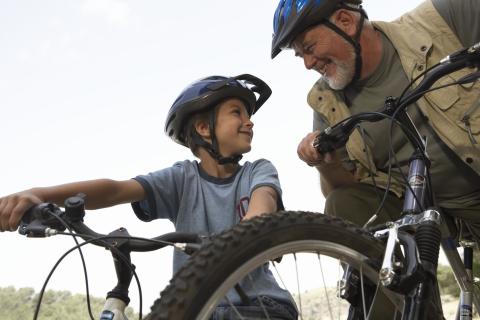
Bike/wheeled Safety
BIKE
There are so many great reasons to ride your bike: It offers fun, freedom and exercise, and it's good for the environment. We want kids and families to ride their bikes as much as possible. Here are a few tips so that you'll be safe while you do so.
The Hard Facts
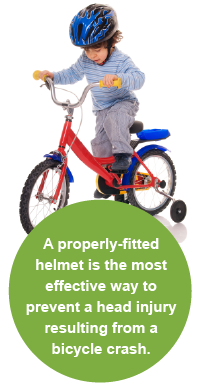
Properly-fitted helmets can reduce the risk of head injuries by at least 45 percent – yet less than half of children 14 and under usually wear a bike helmet.
Top Tips
- Wear a properly-fitted helmet. It is the best way to prevent head injuries and death.
- Ride on the sidewalk when you can. If not, ride in the same direction as traffic as far on the right-hand side as possible.
- Use hand signals and follow the rules of the road. Be predictable by making sure you ride in a straight line and don’t swerve between cars.
- Wear bright colors and use lights, especially when riding at night and in the morning. Reflectors on your clothes and bike will help you be seen.
- Ride with your children. Stick together until you are comfortable that your kids are ready to ride on their own.
SKATING/SKATEBOARDING
Skating and skateboarding can increase balance, agility, coordination and reaction time. It's also pretty fun. With plenty of practice and these safety tips, your kids can roll smart and safe.
The Hard Facts
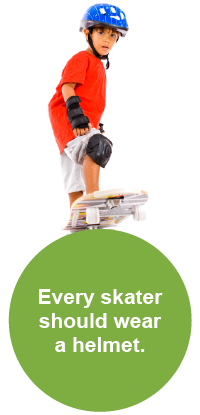
Image
More than 80,000 people are treated in hospital emergency rooms for skateboard-related injuries every year. Skateboarding injuries can range from mild to life-threatening. Skateboarders have been killed by head injuries and collisions with cars.
Top Tips
- Every skater should wear a helmet. Wrist guards, knee pads and elbow pads are a good idea for everyone, but especially for beginners. Mouth guards are good protection against broken teeth.
- Children should ride on smooth, dry surfaces located in a well-lit area away from traffic.
- Teach children to check skates and boards for problems before each use. If there are any cracked, loose or broken parts, the item should not be used until it is repaired.
- Teach children to minimize the impact of a fall by crouching down as they lose balance to reduce the distance to the surface.
In and Around Car Safety
In & Around Cars
We live busy lives, and our cars are an important part of making it all happen. And with a little information and a few simple steps, you can keep your children safe and sound in and around cars, from the time they’re in their first car seat to the time they get behind the wheel.
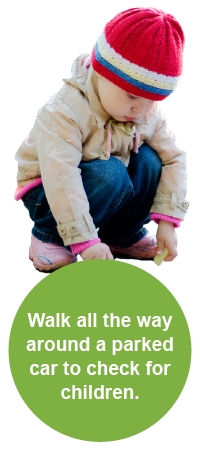
Seven Ways to Protect Kids In and Around Cars
- Car Seat Safety
- Booster Seat Safety
- Seatbelt Safety
- Heatstroke Awareness and Prevention
- Driveway Safety
- Trunk Entrapment Prevention
- Getting Ready to Drive
SEAT BELTS
Do you use your seat belt on every ride? Buckling up on every ride is the single most important thing a family can do to stay safe in the car. Here are a few tips to make buckling up on every car ride.
Hard Facts about Not Wearing Seat Belts
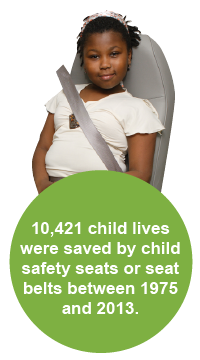
More than half of teens (ages 13-19) and adults (ages 20-44) who died in crashes in 2015 were not wearing a seat belt. (NHTSA)
Top Tips about Wearing Seat Belts
- Don’t be in a hurry to move your child out of the belt positioning booster seat. The adult seat belt usually does not fit well until sometime between the ages of 8 and 12, depending on the size of your child.
- Find out if your child is ready for the seat belt alone by doing the Safety Belt Fit Test:
- Check knees and feet. Your child’s knees should bend at the edge of the seat when her back and bottom are against the vehicle seat back. Her feet should touch the floor for comfort and stability.
- Check the lap belt. The vehicle lap belt must fit snugly across the hips or upper thighs.
- Check the shoulder belt. The shoulder belt must fit across the shoulder and chest, NOT across the face or neck.
- If your child doesn’t pass the test, keep him in a booster seat until he does.
- Remember, just because the seat belt fits your child in one car doesn’t mean the seat belt will fit in all cars. Do the Seat Belt Fit Test in every car before permanently moving from the booster seat to seat belt alone.
- Be a good example. We know that when adults wear seat belts, kids wear seat belts. So be a good example and buckle up for every ride. Be sure everyone in the vehicle buckles up, too
Fire Safety
FIRE SAFETY
Home fires can start and spread quickly, so just a little bit of planning can make a big difference. Make sure to create a home fire escape plan and practice it regularly with your family.
Hard Facts About Fire Safety
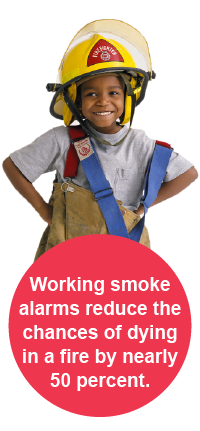
- In 2017, 268 children died in home fires.
- Nearly eighty-seven percent of all fire-related deaths are due to home fires, which spread rapidly and can leave families as little as two minutes to escape once an alarm sounds.
- Fires are not just a problem in the United States. In 2017, more than 27,000 children around the world died due to a fire or burn.
- Working smoke alarms reduce the chances of dying in a reported home fire by fifty percent.
Top Tips for Fire Safety
- Check smoke alarms. Make sure there is a working smoke alarm on every level of your home, inside bedrooms and near sleeping areas. Test smoke alarms every month and replace them every 10 years or when the battery is low.
- Create and practice a fire escape plan. Create a home fire escape plan with two ways out of every room. Choose a place to meet outside that is a safe distance away from your home.
- Practice a home fire drill at least twice a year. Practice a home fire drill with your family during the day and at night. Practice escaping in under two minutes. Sometimes that is all the time you will have to get out of the house safely.
- If there is a fire, leave home immediately. If there is a lot of smoke, get low and crawl out of the house as quickly as possible. Call 911 after you are a safe distance away from your home.
Firearm Safety
GUNS
We need to take extra precautions when kids are in an environment where guns are present.
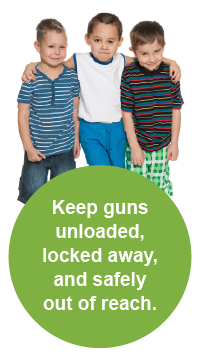
The Hard Facts about Gun Safety
- Children as young as 3 years old may be strong enough to pull the trigger of a handgun.
- Three out of four children living in a house with a gun know where the gun is, even when their parents think they don’t know.
Top Tips about Gun Safety
- Keep guns out of the reach and out of sight of children by storing them securely. Leaving guns unsecured – on a nightstand, table, or other place where a child can gain access – can lead to injuries and fatalities.
- Store guns unloaded and secured with effective, child-resistant gun locks in a locked container out of the reach and sight of children.
- When a gun is not being stored, keep it in your immediate possession and control at all times. Otherwise, store the gun unloaded, locked and separate from ammunition.
- Talk to the grandparents and parents of your children’s friends about guns in the home and how to safely store and secure them.
- If you decide that you no longer need a gun in your home, dispose of it in a safe way. Consult with local law enforcement on the best way to do so.
Safety at Home
BATTERIES
Little kids love to explore, and when they find something new, what’s the first thing they do? Put it in their mouths. Electronic devices are getting smaller, slimmer and sleeker. There are mini remote controls, small calculators, watches, key fobs, flameless candles and musical greeting cards. Kids love to pick them up, play with them and take them apart, often exposing dangerous button batteries inside. Here are few things to remember to make sure these batteries stay where they belong.
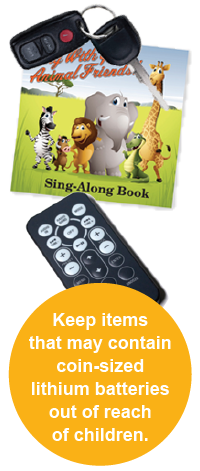
The Hard Facts
Each year in the United States, more than 2,800 kids are treated in emergency rooms after swallowing button batteries. That's one child every three hours. The number of serious injuries or deaths as a result of button batteries has increased ninefold in the last decade.
Top Tips
- Keep coin lithium battery-controlled devices out of sight and reach of children. These include remote controls, singing greeting cards, digital scales, watches, hearing aids, thermometers, children’s toys, calculators, key fobs, t-light candles, flashing holiday jewelry or decorations all contain button batteries.
- Keep loose batteries locked away, or place a piece of duct tape over the controller to prevent small children from accessing the battery.
- Share this life-saving information with caregivers, friends, family members and sitters. It only takes a minute and it could save a life.
- If you suspect your child has ingested a battery, go to the hospital immediately. Don’t induce vomiting or have your child eat or drink anything until assessed by a medical professional.
- Enter the National Battery Ingestion Hotline (800-498-8666) into your phone right now. Call anytime for additional treatment information.
BURNS AND SCALDS
Since young children are still developing, they have thinner skin than adults, which can result in more serious injuries from a burn or scald. One of the ways young, curious kids learn about their surroundings is through their sense of touch. Sometimes their explorations can lead them to reach out and touch hot objects, resulting in an injury. Here are a few simple steps to keep your child safe from potential burns and scalds in your home.
The Hard Facts About Burns and Scalds
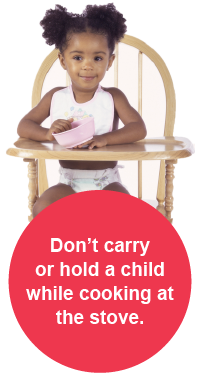
- Fire/burn related injuries are among the leading ten causes of unintentional injury in children ages 0 to 5, with children 2 and younger at greatest risk.
- Every day, 300 children ages 0 to 19 are treated in emergency departments for burn-related injuries.
Top Tips Preventing Burns and Scalds
- Create a kid-free zone. Teach younger children to stay at least 3 feet away from your cooking space. If you need to watch babies while cooking, place them in highchair outside of the kid-free zone where you can see them.
- Keep hot objects out of children’s reach. Cook on the back burners of the stove and turn pot handles away from the edge. Keep hot foods and drinks away from the edge of your counters and tables.
- Teach older children how to cook safely. Make sure they don’t leave the kitchen while cooking and use oven mitts or potholders to carry hot pots and pans.
- Check bathwater temperature. Before placing your child in the bath, check the water temperature with on the inside of your wrist. The water should feel warm to the touch, not hot.
- Watch children around fireplaces. When a gas fireplace is turned on, the glass is extremely hot and can take more than an hour to cool down after it is turned off. Keep children away from the fireplace to prevent burns from the hot glass.
CARBON MONOXIDE
Carbon monoxide (CO) is a gas that you cannot see, taste or smell and because of this, is often called the “invisible killer.” It is created when fuel-burning appliances, such as heating devices, grills, clothes dryers and vehicles, do not burn all the fuel they need to function.
Young children process CO differently than adults, so they may experience more severe side effects and show signs of poisoning quickly. Symptoms of carbon monoxide poisoning include headache, nausea and drowsiness. At its worst, CO can cause severe side effects or even death. However, there are steps you can take to keep your family safe from carbon monoxide poisoning.
The Hard Facts of Carbon Monoxide
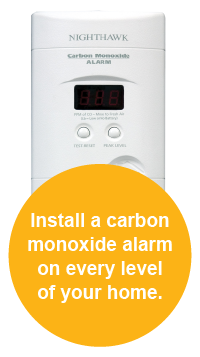
In 2017, poison control centers reported 3,248 cases of carbon monoxide exposure in children 19 and under.
Top Tips for Carbon Monoxide Safety
- Install carbon monoxide (CO) alarms. Make sure there is one on every level of your home, especially around sleeping areas.
- Test CO alarms every month. Replace them according to the manufacturer’s instructions.
- Avoid using gas appliances inside your home. Use generators and grills outside of your home, away from windows and doors. Warm up vehicles outside of your garage.
- In a CO emergency, leave your home immediately. If the CO alarm sounds, quickly leave your home. Move to a safe location outside where you can breathe in fresh air before you call for help.
FALLS
From the moment your baby starts to crawl, the world is a magical place filled with new adventures and discoveries. From a child’s perspective, everything is a potential mountain to climb (that giant bookshelf), obstacle to overcome (those pesky stairs) or mysterious place to investigate (anywhere beyond the safety gate). Little bumps will happen but we’re here to help so these brave expeditions don’t result in something more serious.
The Hard Facts
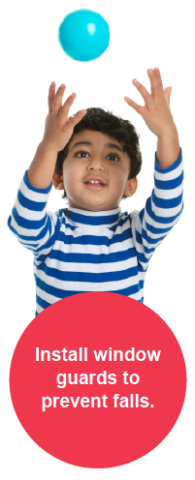
Unintentional falls are the leading cause of non-fatal injuries for children in the United States. In 2013, unintentional falls resulted in nearly 2,578,235 injuries requiring treatment in an emergency room. These injuries resulted from activities such as climbing on furniture, playing near an unsecured window, falling down stairs or playing on playgrounds.
Top Tips
- Screens are meant to keep bugs out, not children in. Properly install window guards to prevent unintentional window falls. For windows above the first floor, include an emergency release device in case of fire.
- Keep babies and young kids strapped in when using high chairs, infant carriers, swings or strollers. When placing your baby into a carrier, remember to place the carrier on the floor, not on top of a table or other furniture.
- Use approved safety gates at the tops and bottoms of stairs and attach them to the wall, if possible. Remember to read the manufacturer’s instructions and warning labels to make sure you have the right gate for your needs. Not all gates are safe for use at the top of stairs.
- Secure TVs and furniture to the wall using mounts, brackets, braces, anchors or wall straps to prevent tip-overs. These kinds of accidents happen more than you might think, so take a few minutes, secure your TV and furniture, and then never worry about it again.
- Take your kids to playgrounds with shock-absorbing surfaces such as rubber, synthetic turf, sand, pea gravel, wood chips or mulch. If your child falls, the landing will be more cushioned than on asphalt, concrete, grass or dirt.
MEDICATION SAFETY
We want to encourage our kids to explore and discover their world, so it’s especially important to include medicine safety when childproofing your home. Here are a few tips on how to keep kids safe around medicine.
Hard Facts about Medication Safety
- Medicines are the leading cause of child poisoning.
Image
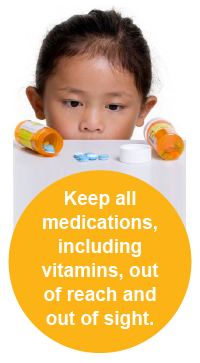
- In 2017, nearly 52,000 children under the age of six were seen in the emergency room for medicine poisoning. That’s one child every ten minutes.
Top Tips about Medication Safety
- Keep medicine up and away, out of reach and sight of children, even medicine you take every day. Kids are naturally curious and can easily get into things, like medicine, if they are kept in places within their reach. Put all medicines and vitamins at or above counter height where kids can’t reach or see them.
- Consider places where kids get into medicine. Children often find medicine kept in purses or on counters and nightstands. Place bags and briefcases on high shelves or hang them on hooks, out of children’s reach and sight.
- Remember products you might not think about as medicine. Health products such as vitamins, diaper rash creams and even eye drops can be harmful if kids get into them. Store these items out of reach and sight of children, just as you would over-the-counter and prescription medicines.
- Give medicine safely to children. Use only the dosing device that comes with liquid medicine, not a kitchen spoon. When other caregivers are giving your child medicine, write clear instructions about what medicine to give, how much to give and when to give it. Using a medicine schedule can help with communication between caregivers.
- Save the Poison Help number in your phone and post it visibly at home: 1-800-222-1222. Specialists at poison control centers provide free, confidential, expert medical advice 24 hours a day. They can answer questions about how to give or take medicine and help with poison emergencies.
- Share medicine safety information with family and friends. Teach other caregivers such as family members, babysitters and friends about medicine safety and make sure they know the Poison Help number.
SLEEP SAFETY AND SUFFOCATION
There is nothing more beautiful than a sleeping baby, especially for parents who are often tired themselves. By following a few simple sleep safety tips, you can create a safe place for your baby to sleep and nap.
The Hard Facts About Sleep Safety
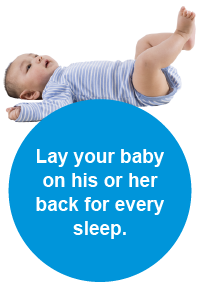
- Unintentional suffocation is the leading cause of injury-related death among children under 1 year old.
- Nearly 3,500 infants die each year in the United States from sleep-related infant deaths..
- Causes of sleep-related infant deaths include suffocation, entrapment, strangulation and Sudden Infant Death Syndrome (SIDS).
Top Safety Tips for Sleep Safety
- Place babies on their backs for naps and at night until they are 1 year old. Make sure babies sleep on a firm, flat surface in their own crib, bassinet or play yard.
- Choose a firm mattress and fitted sheet for baby’s crib. Remove toys, blankets, pillows, bumper pads and other accessories from the crib.
- Dress baby in a wearable blanket, onesie or similar clothing for every sleep. A loose blanket could cover baby’s airway or make their body temperature too high.
- Share your room, not your bed. Place baby’s crib or bassinet in your bedroom instead of letting baby sleep in the same bed with you.
- Follow the manufacturer’s instructions to assemble your crib. Make sure to complete and submit the product registration card to learn about any recalls or safety updates.
Preventing Poisoning
POISON
Let's face it, sometimes kids get into things that they probably shouldn't. Everyday household items such as cleaning products and personal care products can be harmful to kids. Here are a few poison prevention tips to keep little explorers from finding their way into household items that could be dangerous.
The Hard Facts about Poisoning
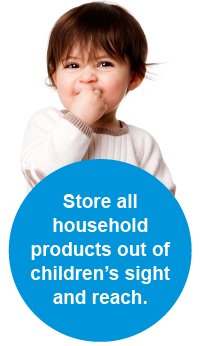
- Poisoning is the third leading cause of unintentional injury death among children ages 1 to 19 years.
- 1,319,044 calls were made to poison control centers in 2015 after a child got into a potential poison, that’s over 3,600 calls a day, 150 every hour.
Top Tips
- Store household products safely to prevent poisoning. Young kids are often eye-level with items under the kitchen and bathroom sinks, so make sure household cleaning products and personal care products up and away, out of children’s reach and sight.
- Keep all household cleaning products in their original containers. Also, when buying products, look for child-resistant containers to help prevent poisoning to children.
- Read and follow product labels. Check for ingredients that can be to kids and make sure you use and store products according to the label. Kids can get into things quickly, so remember not to leave cleaning products or personal care products unattended while you are using them.
- Remember products that might be harmful to kids. Check your home for products like cleaning supplies, liquid laundry packets personal care products, plants, pesticides, alcohol and medicine.
- Save the Poison Help number in your phone and post it visibly at home: 1-800-222-1222. Specialists at poison control centers provide free, confidential, expert medical advice 24 hours a day. They can answer questions and help with poison emergencies.
Water Safety & Drowning
BOATING
During the warm weather months, families across the country will be spending more time enjoying lakes, rivers and oceans. Being aware of the risks these open waters pose, and following these boating safety tips, can keep those outings fun.
The Hard Facts About Boating Safety
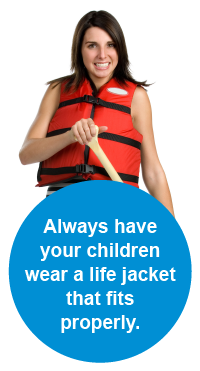
In 2018, 77 percent of all fatal boating accident victims drowned, and of those who drowned, 84 percent were not wearing a life jacket.
Top Tips for Boating Safety
- Wear a U.S. Coast Guard-approved life jacket when boating. Choose a life jacket that is right for your child’s weight and water activity.
- Young kids are at a higher risk for hypothermia, so take extra precautions to keep them warm. If your children seem cold or are shivering, wrap them tightly in a dry blanket or towel.
- I Learn basic water rescue skills and CPR. It is important to know how to respond in an emergency without putting yourself at risk of drowning.
- Follow the U.S. Coast Guard recommendations for boating safety. Learn about available boating resources, such as free vessel safety checks and boating safety courses.
SWIMMING
Whether it’s a trip to the beach or a dip in the community or backyard pool, these swimming safety tips can help you have fun in the sun.
Hard Facts about Drowning
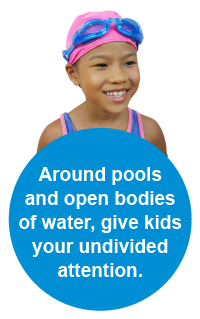
- Drowning is the leading cause of injury-related death among children ages 1-4.
- And it's the third leading cause of unintentional injury-related death among children 19 and under.
- In 2018, 918 children under the age of 19 drowned and more than 7,000 were seen in the emergency room.
Top Tips for Swimming Safety
- Watch kids when they are in or around water. Keep young children and weak swimmers within arm’s reach of an adult. Make sure more experienced swimmers are with a partner every time.
- Choose a Water Watcher. When there are several adults present, choose one to be responsible for watching children in or near the water for a certain period of time, such as 15 minutes. After 15 minutes, select another adult to be the Water Watcher.
- Teach children how to swim. Every child is different, so enroll children in swim lessons when they are ready. Consider their age, development and how often they are around water.
- Make sure kids learn these five water survival skills.
- Step or jump into water over their head and return to the surface.
- Turn around in the water and orient to safety.
- Float or tread water.
- Combine breathing with forward movement in the water.
- Exit the water.
-
Teach children that swimming in open water is different from swimming in a pool. Be aware of situations that are unique to open water, such as limited visibility, depth, uneven surfaces, currents and undertow. These potential hazards can make swimming in open water more challenging than swimming in a pool.
- Learn CPR and basic water rescue skills. It is important to know how to respond in an emergency without putting yourself at risk of drowning. Learning these skills may help you save a life.
WATER SAFETY AT HOME
When you think of places where kids are around water, you may think of recreational areas such as pools, lakes and oceans. But have you thought about the areas in your home where kids can get into water? Use these tips for water safety at home, whether your kids are in bathtubs, backyard pools or around buckets.
The Hard Facts About Drowning
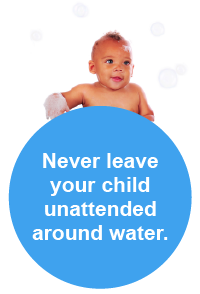
- Drowning is the leading cause of injury-related death among children between 1 and 4 years old.
- And it’s the third leading cause of unintentional injury-related death among children 19 and under.
- Children less than a year old are more likely to drown at home in the bathtub or a bucket.
Top Tips
- Watch kids when they are in or around water, without being distracted. Young children can drown in as little as one inch of water, so it’s important to keep them within an arm’s reach of an adult.
- Empty tubs, buckets, containers and kids’ pools immediately after use. Store them upside down and out of children’s reach.
- Close lids and doors. Keep toilet lids and doors to bathrooms and laundry rooms closed when not in use.
- Install fences around home pools. A pool fence should surround all sides of the pool and be at least four feet tall with self-closing and self-latching gates.
- Learn CPR and basic water rescue skills. It is important to know how to respond in an emergency without putting yourself at risk.